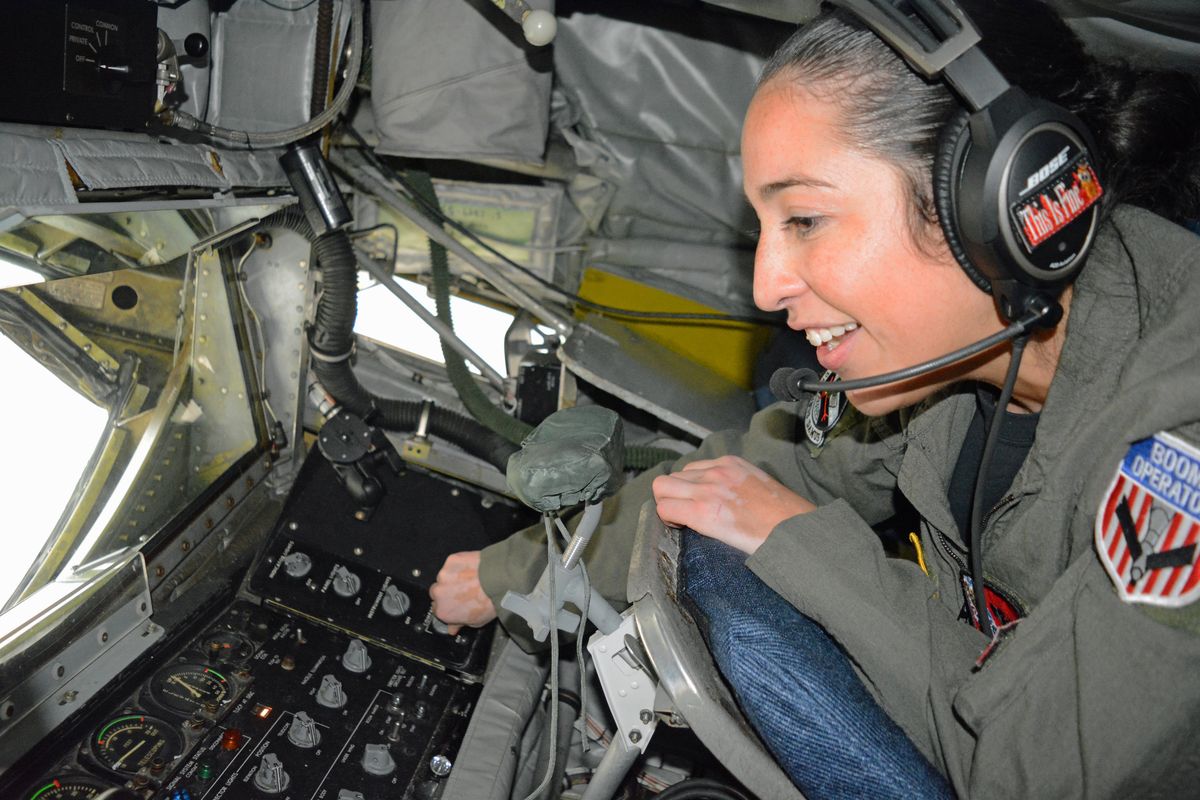‘Gas attendants in the sky’: How Fairchild Air Force Base operators refuel planes mid-flight

For Staff Sgt. Kyle Hunt, refueling an aircraft midflight, tens of thousands of feet in the air, is something like playing a video game.
“Trying to guide in there like a claw machine,” Hunt said. “Trying to get it there perfectly.”
Hunt is a boom operator with the 92nd Air Refueling Wing at Fairchild Air Force Base.
Think of boom operators as “gas attendants in the sky,” Tech. Sgt. Jenny Cook said. She, Hunt and other boom operators do their work from what’s called a “boom pod,” a confined space in the back of a tanker containing the instruments used to carry out the refueling process.
The boom pod of a Boeing KC-135 Stratotanker lends credence to Hunt’s analogy.
There are more buttons and knobs than an arcade cabinet, but the joysticks are familiar. The left extends or retracts the inner tube of the flying boom, the apparatus through which the gas goes to the receiving aircraft. The right moves the boom up and down or side to side. The screen, then, is a skyward window.
“It can be pretty challenging, but that’s why we go through so much training,” Cook said. “We go through simulators that we practice on to make sure we can do it safely before we do it actually in the aircrafts. After enough practice and training, you can get pretty good.”
Boom operators and pilots worked through maneuvers Friday as part of a training run over central Washington.
Personnel aboard four KC-135s took turns making contact runs with a C-17 Globemaster III out of Joint Base Lewis McChord in Tacoma.
The runs took place between 21,000 and 24,000 feet in the air, said Alex “Sloth” Kauth, an instructor at the 509th Weapons Squadron at Fairchild.
On a real mission, the C-17 likely would’ve been fueled with Jet A rather than just a contact run. Kauth said training runs are used by personnel with a range of experience, from those in their late teens to others with a few decades under their belt.
“That’s a huge thing,” he said. “The older, more experienced boom operator, the older more experienced pilot, can pass those lessons down, and that’s what gives the Air Force itself, I think, a really great strength compared to the other industries.”
With Friday’s training, pilots and boom operators coordinated the four KC-135s, each a 136-foot-long tanker with a maximum fuel transfer capacity of 200,000 pounds. Their receiver was the C-17, 174 feet long with a 169-foot wingspan – approximately 39 feet longer than that of the KC-135.
“The difficulty lies in fact that it’s two very large, typically, objects trying to meet up in space in the air,” Kauth said. “A lot of different factors, whether it’s weather, different threats to the aircraft, whatever it might be, it definitely provides a lot of difficulty.
“The guys and gals in the back, the boom operators, to me, they’re the ones that are the shining stars of this,” he continued, “because they have the hard job of making contact in the air with another aircraft.”
Cook said boom operators use colored lights for the receiving aircraft to help guide the process and connect the boom. They do so while laying horizontally in the narrow boom pod.
“If it’s mission-critical, we might have to get it done very quickly, but it’s dependent on the receiver – the aircraft that we’re giving gas to – and our aircraft,” Cook said. “Wake turbulence might be an issue; it might prevent us from making a safe contact. Different factors can hinder making it quick versus taking our time a little bit to be safe.”
Hunt said his responsibilities as a boom operator also include checking over the tanker for anything – such as leaks or faulty circuit breakers – prior to takeoff, as well as making sure passengers are briefed on proper safety procedures.
“I think it’s awesome,” Hunt said of his role. “Get to fly all the time. Get to see all these other jets. Get to go different places. Just exciting.”
“The office view changes every day, every time we’re up in the air,” Cook said. “Sometimes, it could be over the ocean. Next thing you know, you’re over the mountains in the Middle East somewhere, so it’s really awesome. I love it.”